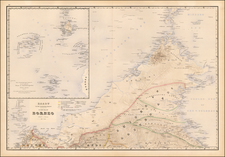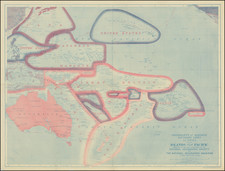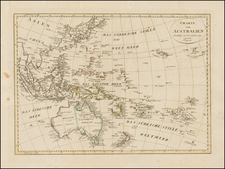Attractive old color example of Frederick De Wit's map of the Pacific Ocean, first issued circa 1675.
The map shows California as an Island and important early projections of Australia and New Zealand, showing information from Tasman's two voyages in 1642-3 and 1644. The early discoveries by the Dutch on the northern coast of Australia and New Guinea reflect the prevailing opinion that the two were connected. Van Diemens Land is shown, as is the west coast of New Zealand.
One of the earliest obtainable sea charts of the Pacific Ocean.
Decorated with 4 sailing ships, compass rose, rhumb lines and a striking cartouche, with Magellan's portrait. One of the best Pacific Ocean Maps of the period.
The map is known in 4 states:
- 1675 circa: imprint of Frederick De Wit
- 1680 circa: I. de S. Andries off Baja
- 1715: imprint changed to L. Renard
- 1745: imprint changed to R & I Ottens
De Wit (1629 ca.-1706) was a mapmaker and mapseller who was born in Gouda but who worked and died in Amsterdam. He moved to the city in 1648, where he opened a printing operation under the name of The Three Crabs; later, he changed the name of his shop to The White Chart. From the 1660s onward, he published atlases with a variety of maps; he is best known for these atlases and his Dutch town maps. After Frederik’s death in 1706, his wife Maria ran the shop for four years before selling it. Their son, Franciscus, was a stockfish merchant and had no interest in the map shop. At the auction to liquidate the de Wit stock, most of the plates went to Pieter Mortier, whose firm eventually became Covens & Mortier, one of the biggest cartography houses of the eighteenth century.









![[ Earthquake Fault Lines ] Reconnaissance Map of the West Side of Sacramento Valley . . . 1920](https://storage.googleapis.com/raremaps/img/small/101680.jpg)


![Chart of the Coast of California from San Blas to San Francisco Drawn chiefly from the Spanish Surveys, the Charts of Vancouver &c. the whole much improved by recent observations made by English and French Naval Officers . . . 1854 [Additions to 1862]](https://storage.googleapis.com/raremaps/img/small/58999.jpg)

